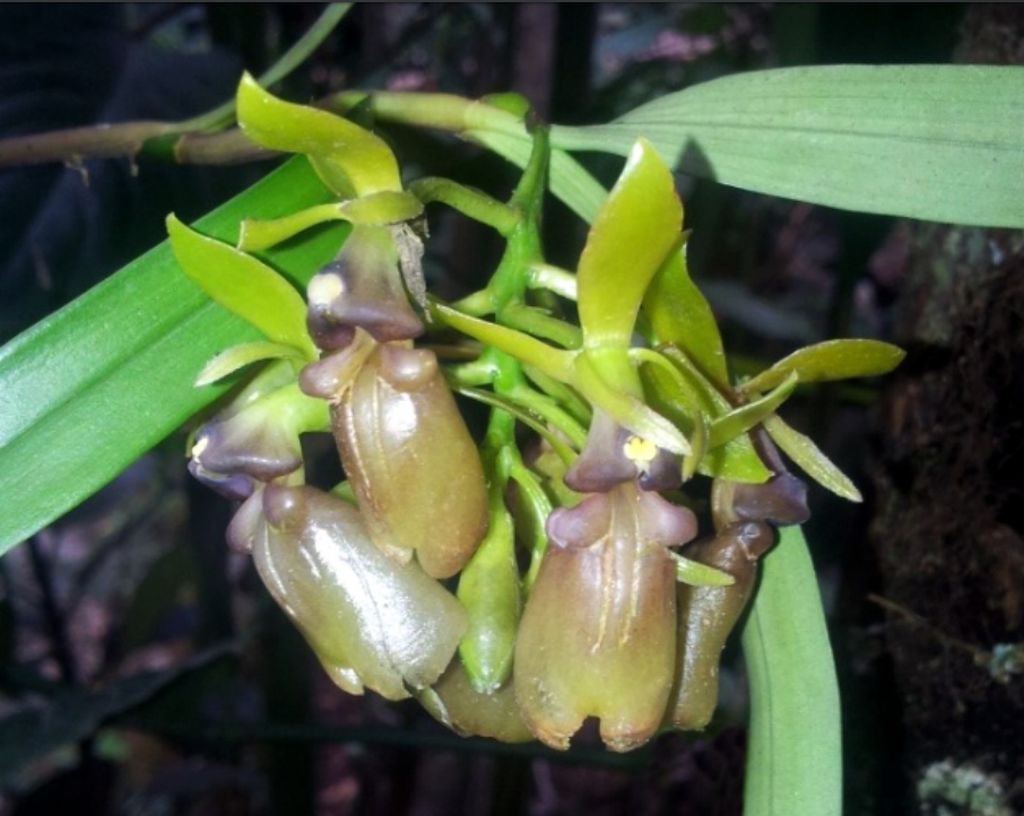

Epidendrum guislainae Hágsater & C.Soto 2018 GROUP Arbusculum SUBGROUP Incomptum
Photo © by C Soto/TYPE Drawing © by R Jimenez and The AMO Herbario Website



Common Name Guislaina's Epidendrum [Peruvian Mrs. Denise Guislain-Koechlin who is responsible for the extraordinary native gardens of Inkaterra: Inkaterra Machu Picchu Pueblo Hotel, Inkaterra Hacienda Urubamba, Inkaterra Reserva Amazónica and Inkaterra Hacienda Concepción current]
Flower Size 1.2" [3 cm]
Found in southern Peru, on the Amazon slope of the Cordillera Oriental of the Andes, in montane forest at elevations of 1800 to 2040 meters as a large sized, cool growing epiphyte with simple, cane-like, terete, straight, the new produced from the middle of a sub-apical internode of the previous stem and carrying 3 to 4, sub-coriaceous, smooth, striate leaf-sheath; blade articulate, narrowly oblong, acute, margin entire leaves that blooms in the spring on a terminal, without a spathe, peduncle .6 to .8" [15 to 20 mm] long, laterally compressed, ancipitose, rachis unornamented, 2.4" [6 cm] long overall, apical, from the mature stem, flowering only once, nodding, racemose, successively 2 to 7 open at one time, 3 to 10 flowered inflorscence with triangular, acuminate, shorter than the ovary floral bracts and carrying resupinate, green flowers with the column, calli and mid-rib of the lip tinged purple, especially the apex of the column which may be a solid purple; fragrance not registered.
"Epidendrum guislainae belongs to the GROUP Arbusculum SUBGROUP Incomptum which is characterized by the erect habit with successive lateral growths produced from the middle of the previous growth, few leaves aggregate towards the apex of the stems, roots generally only from the base of the primordial stem, with short apical inflorescences and fleshy yellowish to green to violet-green to black flowers with short ovaries, the lip entire to 3-lobed. The species is recognized by the sub-coriaceous leaves, the successive large flowers, sepals .78 to .8" [17.7 to 20 mm] long, without any prominent ventral nectary which inflates the ovary, a obreniform lip, with large, fleshy divergent calli, the margin of the petals and lip minutely ciliate. Epidendrum evelynae has smaller flowers, sepals .36 to .44" [9 to 11 mm]long, a reniform, bicallose lip, the calli small and parallel, and the linear, 1-veined petals with the margin denticulate-erose. Epidendrum chimantense Hágsater & Carnevali has the purple-tinged leaf-sheaths, narrow, elliptic-lanceolate leaves, the column arching only at the base and a slender, non-inflated ovary, sepals .36 to .4" [9 to 10 mm] long, lip reniform, .14 to .24 x .26 to .36" [3.5 to 6.0 x 6.5 to 9.0 mm]. Epidendrum lechleri Rchb. f., a species native to Peru, has .52" [13 mm] long sepals and a 3-lobed lip. Epidendrum nephroglossum Schltr. has very prominent floral bracts equal or longer than the ovary which is not swollen, .44 to .66" [11.0 to 16.5 mm] long sepals, acute petals, lip .28 x .56" [7 x 14 mm], and an obsolete clinandrium. Epidendrum bakrense Hágsater & Cremers has wider petals and shorter segments, sepals .28 to .3" [7.0 to 7.5 mm] long, with a much-inflated ovary, and the column apex with a rounded lobe above the calli, not a tooth. Epidendrum rousseffianae Collantes & Hágsater has somewhat similar reniform lip, but the plant is quite different, with monopodial, branching stems, sepals are .76 to .8" [19 to 20 mm] long and lip 1.16 x.6" [2.9 x 1.5 cm]. *NOTE: We previously illustrated the Icon of Epidendrum evelynae (Santiago & Hágsater, 2015), with a photograph of this new species taken by Gloria Calatayud from Cusco. Now with an inflorescence in spirit, we have been able to prepare an illustration of the material from Machu Picchu, and it is clearly distinct from that of Bolivia, especially by the flowers twice as large, and large fleshy divergent calli, and the minutely ciliate margin of the petals and lip. Vásquez and Ibisch (2004) treated this E. evelynae as a synonym of Epidendrum lechleri Rchb. f.." Hagsater etal 2018
Synonyms
References W3 Tropicos, Kew Monocot list , IPNI ;*Icones Orchidacearum 16[2] Plate 1674 Hagsater & Sanchez 2018 drawing/photo fide;
----------------------------------------------------------------------------------------------------------